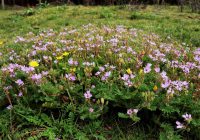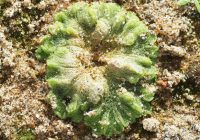Dr Phil Smith’s Wildlife Notes
October 2014
Continuing this autumn’s warm theme, October was officially about 1oC above normal, though it felt more than that, Halloween achieving an all time record high in the south-east. The regional rainfall totals were 137% of average but this did not make up for the September drought, so only the deepest of our sand-dune wetlands showed any surface water by the end of the month.
As usual at this time of year, I spent much of my time writing reports on summer studies, especially the mammoth volunteer survey of Japanese Rose discussed in the August notes. Mounting concerns about the rapid spread of this alien shrub in the countryside were not eased when the BBC presenter Monty Don was shown enthusiastically planting Japanese Rose during Gardener’s World and then “highly recommending” it for hedging. He had already blotted his copybook earlier in the year by including Sea Buckthorn in a magazine article as his “plant of the month”! What next – Japanese Knotweed?! The second year of our organised volunteer “buckthorn bashes” started this month with three well-attended sessions cutting Sea Buckthorn regrowth near Sands Lake, Ainsdale. Perhaps I should invite Mr Don!
Time spent writing did not prevent me getting out and about on the coast, a visit to the Sands Lake area on 2nd being graced by several Common Darters and Migrant Hawkers, while a Wall butterfly was probably the latest I have seen. Around the lake, large patches of Narrow-leaved Michaelmas-daisy Aster lanceolatus were just coming into flower. This is one of several Michaelmas-daisies that are spreading on the sand-dunes as garden-escapes and which may become a conservation problem, although they are useful nectar sources for late-flying butterflies. The same day, scarcer native plants still in flower on Birkdale Green Beach included both Seaside and Lesser Centaury and Yellow-wort, all members of the Gentian family. Another October flower seen widely in the dunes is the hybrid between Common and Sticky Stork’s-bill, Erodium ×anaristatum. Having larger pink blooms than its parents and hardly any fruits, this is a rare plant nationally. Away from the Sefton Coast, it is largely restricted to a few sites in North Wales.
Generally, I don’t “do” mosses and liverworts but finding an unfamiliar thallose liverwort on damp bare sand at Cabin Hill, I sent a photo to local expert Des Callaghan. It turned out to be the nationally scarce Cavernous Chrystalwort Riccia cavernosa, rarely recorded on the coast and new to Cabin Hill National Nature Reserve. Nearby, flowering Atlantic Ivy in Ravenmeols woods attracted a dozen Red Admirals and a Comma, a single Painted Lady being much more unusual here. Logs and fence posts near Asparagus Cottage were swarming with Harlequin Ladybirds and their spectacular larvae. This non-native beetle has only been seen in our region for a couple of years or so and is rapidly spreading north. Its surprisingly active and rapacious larvae were snacking on aphids that had fallen from overhanging Sycamores.
Early in the month, bird enthusiasts flocked to Martin Mere for a record influx of 45,800 Pink-footed Geese, reflected locally by 1200 on a stubble field just east of Cabin Hill. Also typical of late autumn were lots of Goldcrests calling from trees at Ravenmeols, while four Buzzards and a Peregrine soared overhead. I was pleased to find a juvenile Whinchat at Hightown on 11th but the star bird of the month was a Cetti’s Warbler that turned up in the big reed-bed next to the R. Alt at Hightown. On 29th, it was singing loudly only about 20 feet into the reeds but a sighting of this notorious skulker eluded me. An unassuming little brown bird with a white eye-stripe, Cetti’s Warbler used to be seen mostly around the Mediterranean but it then moved north, first appearing in Britain in 1961. It has since become quite well established in southern England, reaching Lancashire in 1990, the first confirmed breeding taking place at Marton Mere, Blackpool in 2010.




